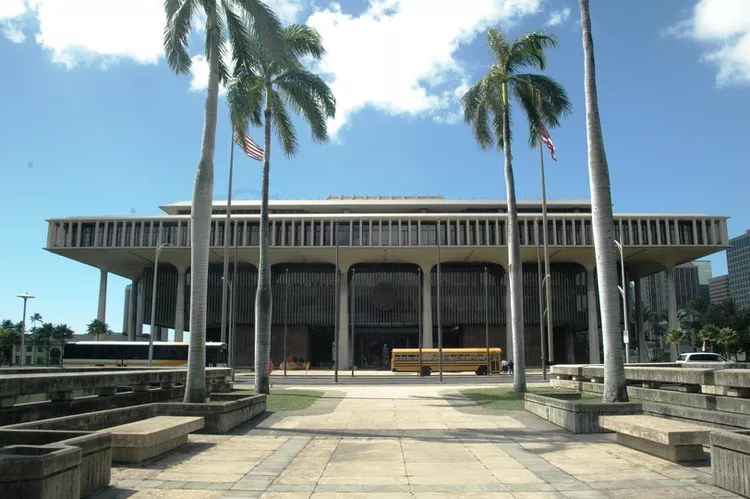Summary
History
The planning for the construction of the Hawaii State Capitol building began in 1960, yet the actual plans were finalized only in 1964. Groundbreaking occurred in November 1965, and it was not until March 15, 1969, that the building was officially dedicated, marking nearly a decade since the initial planning phase.
Prior to the establishment of this new building, the historic ‘Iolani Palace served as the seat of the state government.
The complete cost for constructing the State Capitol building amounted to $24,576,000.
Architecture

This remarkable building is primarily constructed from nearly 50,000 cubic yards of reinforced concrete, complemented by 7 million pounds of structural steel. The structure measures an impressive 360×270 feet and stands approximately 100 feet tall, akin to the height of a ten-story building.
The building is beautifully set within a reflecting pool, symbolizing the creation of the Hawaiian Islands from the sea.
The conical design of the koa wood-paneled legislative chambers evokes the majestic volcanoes responsible for the islands’ existence. Each legislative chamber includes a balcony-level spectator gallery, accommodating 180 guests.
Additionally, the 40 pillars encircling the structure, which nearly reach its apex, are reminiscent of the iconic palm trees found throughout Hawaii.
Both the ocean-facing and mountain-facing sides of the building feature replicas of the State Seal, each measuring 15 feet in diameter and weighing over 7,500 pounds.
Underneath the reflecting pool lies a parking garage capable of accommodating 440 vehicles.
Capitol Grounds – Queen Liliuokalani Statue

Within the grounds of the Capitol lie several notable points of interest.
Located on the makai (ocean) side of the building, between the Capitol and ‘Iolani Palace, is the statue of Queen Liliuokalani, the last reigning monarch of Hawaii.
Created by the talented artist Marianna Pineda, the statue pays tribute to a woman renowned for her extraordinary courage, compassion, and musical talent.
Her reign was marked by significant political turmoil, culminating in the overthrow of the monarchy in 1895, the proclamation of a republic, and the eventual annexation of Hawaii by the United States in 1898. Queen Liliuokalani lived under detention at the ‘Iolani Palace and later at Washington Place until her passing in 1917.
Capitol Grounds – Father Damien Statue

Located on the mauka (mountain) side of the Capitol building are two significant points of interest—a statue of Saint Damien and a replica of the Liberty Bell.
Father Joseph Damien de Veuster, canonized by Pope Benedict XVI in 2009, was a Belgian priest who dedicated himself to serving the residents suffering from Hansen’s Disease on the island of Moloka`i from 1873 until his demise from the same affliction in 1889.
His statue was sculpted by French artist Marisol Escobar, and a second version of this statue can be found in the National Statuary Hall Collection in the United States Capitol.
Presented to Hawaii in 1950, the replica of the Liberty Bell is also situated on the mauka side of the Capitol building, with the original residing in Independence National Historical Park in Philadelphia, PA.
Also Within the Capital District

Visitors to the State Capitol should not overlook the Eternal Flame, located on the grounds of Washington Place. This flame serves as a tribute to the men and women of Hawaii who have bravely served in the armed forces. Designed by artist Bumpei Akaji, the flame was dedicated in 1974.
Additionally, the Korean and Vietnam War Memorial is beautifully situated alongside Richards Street, nestled between the Capitol and the Hawaii State Art Museum. Established in 1994, this wall memorializes the soldiers from Hawaii who sacrificed their lives during these two conflicts.
Moreover, visitors will likely wish to explore ‘Iolani Palace, the only royal palace located within the United States.
State Capitol Tours

Self-guided tours of the Hawaii State Capitol are available Monday through Friday from 9:00 a.m. to 3:30 p.m. year-round, excluding state holidays. The Capitol remains closed on weekends. However, it is essential to note that the House and Senate Galleries will not be accessible during these self-guided tours.
A self-guided tour pamphlet, along with additional visitor information, is provided at the Governor’s Office of Constituent Services, located in Room 415 on the 4th floor of the Capitol building. The self-guided tour pamphlet, children’s activity booklets, and a map of the Capitol district are accessible for download.





